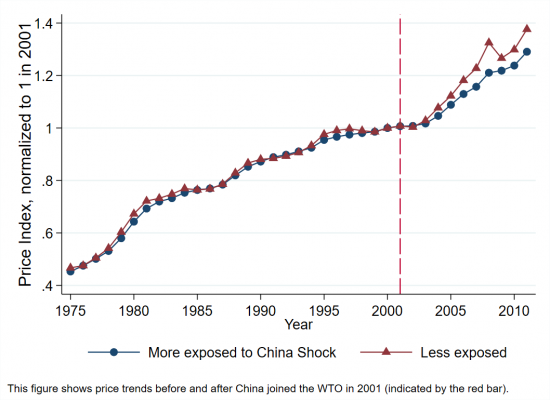
International trade is widely viewed as creating winners and losers in an economy. Influential work has documented that US labour markets were heavily disrupted by the surge of imports following China’s joining the World Trade Organisation in 2001, a historic change in trade widely referred to as the “China shock”. Much less is known, though, about the extent to which the “China shock” may have actually benefited US consumers by reducing prices and thereby increasing their purchasing power. So, what were the price effects of the China shock and its consequences for US consumers? Did the effects of reduced prices outweigh the US-job losses that came with them?
In new research, we study comprehensive price data on hundreds of thousands of products to estimate the price effects of the China shock, focusing on the period from 2000 to 2007. Our analysis yields two main lessons: US consumers benefited from the large price declines in product areas where imports from China increased; and the positive impact of the China shock on the purchasing power of US consumers is very large in comparison to its negative impact on US jobs.
The China shock left households better off
We found that prices fell substantially in product categories in which imports from China increased after 2001: specifically, prices fell by 2 per cent when China’s market share increased by one percentage point. In addition, we find that on average, each US household saw its annual purchasing power increase by $1,500 thanks to lower prices caused by increased trade with China from 2000 to 2007. These gains from lower prices were broadly shared across all income groups in the economy, although they were proportionally larger for low-income groups (with gains about 15 per cent larger than average).
The comprehensive price data we use for this analysis has several advantages: we estimate price changes while holding products’ quality constant, so that price declines reflect a true increase in purchasing power (not a decline in quality); and furthermore, through a series of statistical analyses we can estimate the causal impact of trade on prices (rather than simple correlations). Essentially, we compare two groups of products that are similar in every way except that one group faced a greater increase in imports from China. Figure 1 depicts this comparison and shows that prices fell in product categories that were more exposed to the China shock.
Figure 1. The effect of the China shock on US prices

We find that much of the large price response to the China shock comes from a fall in the price of domestically produced goods, rather than from the prices of products imported from China alone. This finding indicates that increased competition led to lower prices for US consumers. In a time a rising market concentration, trade may be particularly valuable to US consumers.
US consumers were better off overall, despite job losses
Trade creates winners and losers: in the case of the China shock, US consumers benefited through lower prices while some US workers were hurt. How do these effects compare to each other? We linked the price data to detailed labor market data to precisely compare the employment and price effects of the China shock.
We find that the economy-wide increase in purchasing power for US consumers was very large in comparison to the labor market disruptions: trade with China increased the total purchasing power of US consumers by $411,464 for each displaced job (while average annual pay for jobs in these industries is about $40,000). This finding implies that the overall gains to US consumers through lower prices are large enough to compensate all US workers who lost their jobs due to increased competition from China in their industries.
In practice, compensating the exact individuals who lost their jobs because of trade may be challenging. It requires policy makers to find and implement the proper policies to redistribute the gains from the winners to the losers. But our results indicate that there is much room to organize such transfers, because the consumer gains are large. For example, this could potentially be achieved through job training, relocation allowances or income support within federal programs such as the Trade Adjustment Assistance (TAA).
♣♣♣
Notes:
- This blog post appeared first on the LSE USA blog. It’s based on ‘What are the Price Effects of Trade? Evidence from the U.S. and Implications for Quantitative Trade Models’, Centre for Economic Policy Research (CEPR), Discussion paper DP13902.
- The post gives the views of its author, not the position of LSE Business Review or the London School of Economics.
- Featured image by Martin Abegglen, under a CC-BY-SA-2.0 licence
- Before commenting, please read our Comment Policy
 Xavier Jaravel is an assistant professor of economics at LSE. He received his PhD from Harvard University in 2016. His recent research examines how changes in productivity (for example, from innovation or from trade) are distributed in society and affect inequality.
Xavier Jaravel is an assistant professor of economics at LSE. He received his PhD from Harvard University in 2016. His recent research examines how changes in productivity (for example, from innovation or from trade) are distributed in society and affect inequality.
 Erick Sager is a senior economist in the prices and wages section of the Federal Reserve Board.
Erick Sager is a senior economist in the prices and wages section of the Federal Reserve Board.





